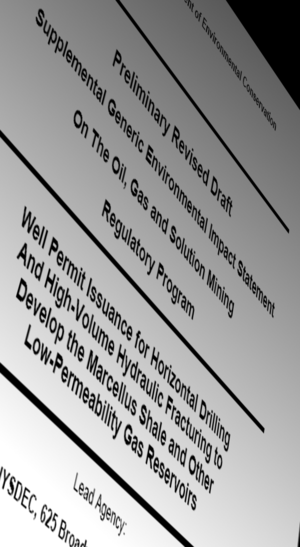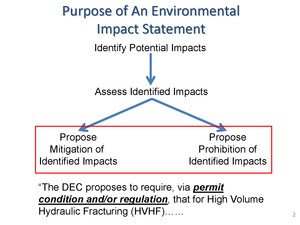SGEIS (NY)
Welcome to the NY SGEIS Quick-Start Guide!
Permalink: TinyURL.com/NYSGEISQuickStart
This is an ultra-short explanation of the legal authority of the SGEIS, and a brief history. You should be able to read and understand this document in 5 to 10 minutes. If it seems like gobbledegook, just read it again :)
|
Please read this urgent message for all New York. |
While the term GEIS / EIS is itself generic, you are probably here to learn about a specific GEIS, i.e., the Preliminary Revised Draft SGEIS on the Oil, Gas and Solution Mining Regulatory Program for Well Permit Issuance for Horizontal Drilling and High-Volume Hydraulic Fracturing to Develop the Marcellus Shale and Other Low-Permeability Gas Reservoirs (July 2011).
Wow, that's quite a mouthful! This is why most of us refer to this as "The SGEIS" (pronounced "ess-guys" or "ess-g'ice").
This is a revision of a document issued by the NY Department of Environmental Conservation which regulates the permitting of the oil and gas exploration and production in the state of NY. The SGEIS makes reference to regulations (as of now, still incomplete), but the SGEIS is not itself, regulation.
This document has undergone several revisions lately to address the impacts of several new technologies for shale gas development in the State of New York.
The current revision, the July 2011 Preliminary Revised Draft SGEIS, is here:
History
SEQRA
The legal authority of the GEIS document (or EIS) derives from a law called SEQRA,
In 1976, the NY State Legislature enacted the State Environmental Quality Review Act ("SEQRA"), part of the Environmental Conservation Law, with the intent,
"...to declare a state policy which will encourage productive and enjoyable harmony between man and his environment; to promote efforts which will prevent or eliminate damage to the environment and enhance human and community resources; and to enrich the understanding of the ecological systems, natural, human and community resources important to the people of the state."
SEQR establishes a process to systematically consider environmental factors early in the planning stages of actions that are directly undertaken, funded or approved by local, regional and state agencies. By incorporating environmental review early in the planning stages, projects can be modified as needed to avoid adverse impacts on the environment." -- From the NY SEQR Handbook
Certain Acts Require an EIS under SEQRA
SEQRA requires that if an action -- such as building a pipeline, drilling a well, or drilling many wells-- is likely to cause "significant adverse impact", an Environmental Impact Statement (EIS) must be prepared "to explore ways to avoid or reduce adverse environmental impacts or to identify a potentially less damaging alternative. If, on the other hand, the determination is made that the proposed action will not significantly impact the environment, then a Negative Declaration is prepared which ends the SEQR process." (ibid).
Purpose of an EIS
The purpose of an Environmental Impact Statement is to
- Identify possible risks to the environment,
- Assess potential impacts, and then to either
- Propose prohibition of those activities likely to cause harm, or
- Propose mitigation, or ways to reduce the harm.
The document, in absence of other state regulations, lacks the power of enforcement. It can only "suggest potential mitigation of potential impacts". (Ingraffea, 7-25-2011)
An EIS is not Regulation!
A common mistake one hears is that "NY has the best regulations in the country!" when referring to the GEIS for Oil, Gas, and Solutions Mining. In fact, the GEIS only determines the well-permitting application process. The actual regulations are very scant, amounting to about 5 paragraphs for gas drilling. See: [1]
Generic EIS
According to the Handbook, and also 6 NYCRR §617.10, a Generic EIS (GEIS) may be appropriate if:
- a number of separate actions are proposed in a given geographic area and which, if considered singly, may have minor effects, but if considered together may have significant adverse environmental impacts;
- a sequence of related or contingent actions is planned by a single agency or individual;
- separate actions share common (generic) impacts; or
- a proposed program or plan would have wide application or restrict the range of future alternative policies or projects.
As a practical matter, the Oil and Gas industry desire to have a "Generic Environmental Impact Statement" if they are going to be drilling thousands of wells. Otherwise, if it is a Type-1 action (an action likely to have adverse environmental impact), then this would require a separate EIS for each well. This would make fracking cost-prohibitive.
The 1992 Oil, Gas, and Solutions Mining GEIS
In 1992, the NY Department of Environmental Conservation (DEC) issued a Generic Environmental Impact Statement on "Oil, Gas and Solution Mining".
New technology demands revision (the SGEIS)
However, the recent technological developments of High-Volume, Slick-Water, Horizontal Hydraulic Fracturing along Long Laterals for Natural Gas in Shale formations is such a new technology, little of the old document was relevant. And since the size of the formation so large, and the potential impacts were so great, in July 2008, then Governor David Patterson directed the DEC to prepare the Supplemental GEIS (SGEIS), which effectively placed a moratorium on drilling horizontal wells in the New York part of the Marcellus Shale formation.
The 2009 Draft SGEIS
A Draft Supplemental Generic Environmental Impact Statement (dSGEIS) was issued in September of 2009, and has been in process since then. This document was widely criticised as being "woefully inadequate" and one petition garnered 10,000 signatories asking the governor to withdraw the document. Public hearings were held all over the state, and the DEC received over 13,000 comments on the document.
The Present
July 2011 Preliminary Draft SGEIS
In July 2011, a Preliminary Draft version of the SGEIS was released, after the DEC was ordered by Governor Cuomo to expedite the process. A "final" version is expected in August 2011.
This document was also criticized in several key areas:
- Certain watersheds (NYC and Syracuse) received special protections, while others do not
- Big holes in how the wastewater will be dealt with,
- Cumulative Impacts not adequately addressed.
Flaws with the July 2011 document
People from around the state are presently reading this ~1100 page document, and publishing their analysis. Please see this page for a master list of these criticisms: 2011 SGEIS Flaws(NY) ...and please... ADD YOUR OWN! (the beauty of a Wiki!)
Thanks to CMD for hosting this Wiki!!!
Please consider making a donation to the Center for Media and Democracy for hosting this Wiki and for the other excellent work they are doing!

